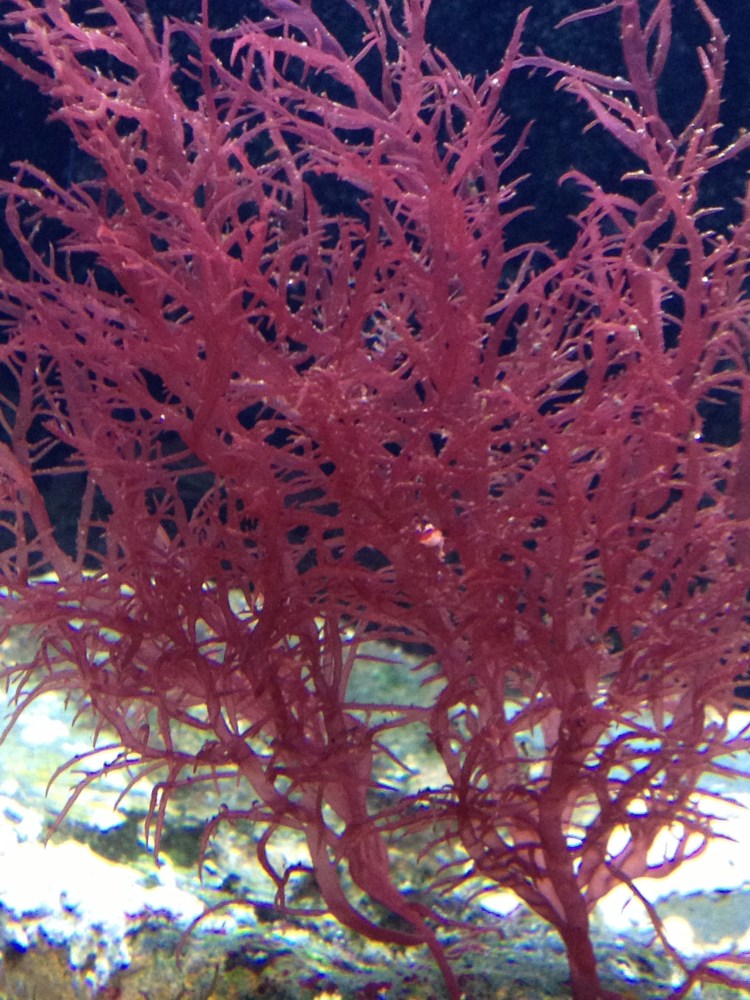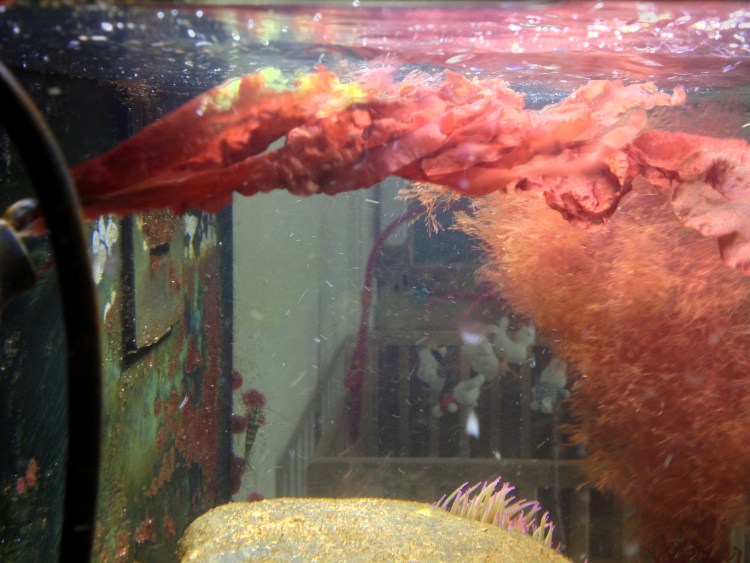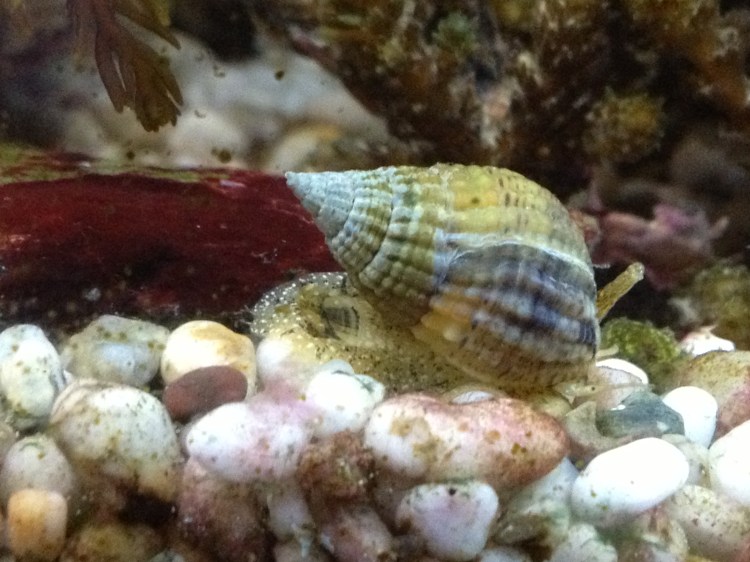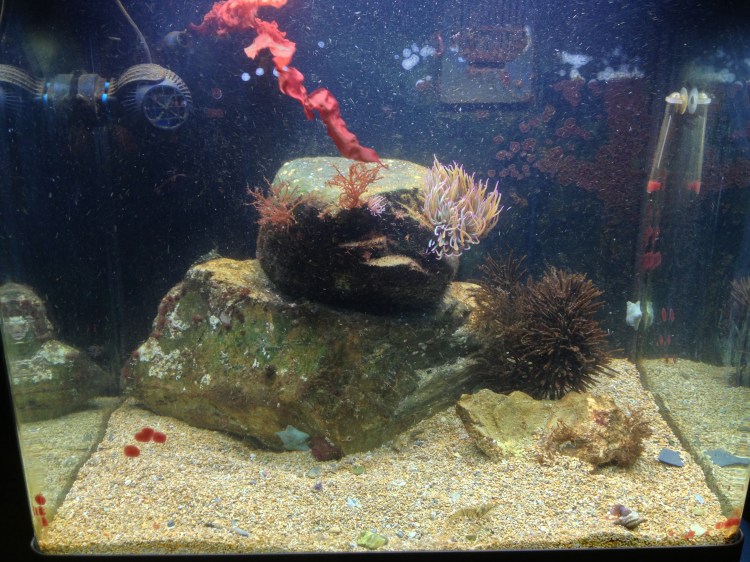A final post summarizing my experiences with seaweeds and writing this, I have regained my enthusiasm for trying to grow seaweeds in my aquarium. My New Years Resolution will be to get a proper marine planted tank going again! (The fact that the aquarium, currently devoid of seaweeds, looks less than great at the moment has made the decision to change it around easier as well…)
5. Some seaweeds establish naturally in the aquarium
I mentioned in the first seaweed post that it can be hard to ‘plant’ seaweeds in the aquarium but sometimes they just settle by themselves. One of my favourites, Chrysymenia wrightii (consistently misidentified as Dudresnay’s whorled weed throughout this blog…) started growing spontaneously from a rock:
This is currently happening with bright green Sea lettuce Ulva and what is probably Devil’s tongue weed Grateloupia turuturu. The outlet grid of the Tunze nanostream is a good place for seaweeds to settle it seems; I have currently a little pluck of Flax brick weed Chaetomorpha linum growing and had a couple of other species there in the past too. Spontaneous growth is of course the best way to get a seaweed aquarium going.
6. A list of Seaweed species I had in my aquarium
Perhaps of interest to a handful of people… I have tried to list all seaweeds I managed to identify and remember, and whether they did well (YES) or not (NO) in my unchilled aquarium (lighting spectrum and intensity used varied somewhat over time). Why some species did not do well I have no idea (see previous post); in some cases, seaweeds were eaten. I have not tried larger species such as Kelp as my aquarium is not that big.
Above: Green (Velvet horn), Brown (Wireweed) and Red (Harpoon Weed) seaweeds in the aquarium.
Red Seaweeds:
Solier’s red Stringweed Soliera chordalis – YES
Chrysymenia wrightii (no common name) – YES
Dulse Palmaria palmata – NO (eaten)
Harpoon weed Asparagopsis armata – NO
Common coral weed Corallina officinalis – NO
False eyelash weed Calliblepharis jubata – NO
Dumont’s tubular weed Dumontia cortorta – NO
Clawed fork weed Furcellaria lumbricalis– NO
Red grape weed Gastroclonium ovatum – NO
Bunny ears Lomentaria armentata – NO
Devil’s tongue weed Grateloupia turuturu – YES
Iridescent drachiella Drachiella spectabilis – NO
A tangle of different Red Seaweeds:
Brown seaweeds:
Estuary wrack Fucus ceranoides – YES
Serrated wrack Fucus serratus – YES
Bushy berry wrack Cystoseira baccata – NO
Bushy rainbow wrack Cystoseira tamariscifolia – NO (still my holy grail)
Wireweed Sargassum muticum – YES (this proved to be the easiest one of all to keep)
Green Seaweeds:
Common green branched weed Cladophora rupestris – NO
Flax brick weed Chaetomorpha linum – YES
Sea lettuce Ulva (lactuca) – YES
Velvet horn Codium tomentosum – YES
So 9 out of 21 species did OK in my aquarium which is actually not too bad (although I have forgotten a number of species that did not do well). Unsurprisingly, the invasive species were easiest to keep (5 YES in 16 natives, 4 YES in 5 non-natives; the difference is not statistically significant though).
Finally, I just wanted to mention that I have been updating the ‘links’ page recently. Regular commenter Marius has recently started a great blog about his new native marine aquarium with organisms collected at the west coast of Ireland: Irish Rockpool Aquarium Adventures, go check it out. A very nice rock pooling blog also is The Salty Scavenger which features loads of seaweed pictures. From now on, I will also register my rock pooling finds online here; with lots of volunteers doing that a great resource will be created that can be used for protecting marine habitats which of course is very important! I have also added a bunch of really useful links to facebook pages, for instance the ‘Coldwater Marine Aquarium Owners‘ group page.


































